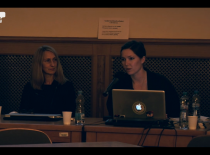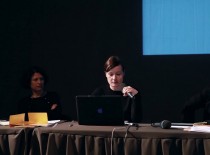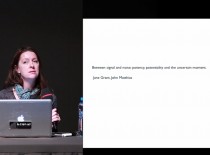Prague - December 7, 2012
Georg Tremmel & Shiho Fukuhara present their paper within the panel Blueprints for the Unknown at International conference MutaMorphosis in Prague, Czech Republic.
Claude Elwood Shannon is primarily known for the formulation of his Information Theory, in which he mathematically defines the technical prerequisites for communication, such as channel capacity, data compression and error correction. Shannon explicitly excludes the question for the meaning of the transmitted information, but this was later resolved by Marshal McLuhan’s famous postulate that ‘the medium is the message’. Another, lesser-known side of Shannon’s talents was that of a tinkerer and inventor. His work in this area included amongst others chess playing machines, a two-seated unicycle, a petrol-powered pogo and various kinds of juggling automata. But one of his most celebrated machines was the so-called ‘Ultimate Machine’. The author Arthur C. Clarke described it like this:
“Nothing could be simpler. It is merely a small wooden casket, the size and shape of a cigar box, with a single switch on one face. When you throw the switch, there is an angry, purposeful buzzing. The lid slowly rises, and from beneath it emerges a hand. The hand reaches down, turns the switch off and retreats into the box. With the finality of a closing coffin, the lid snaps shut, the buzzing ceases and peace reigns once more. The psychological effect, if you do not know what to expect, is devastating. There is something unspeakably sinister about a machine that does nothing — absolutely nothing — except switch itself off.”
We are taking this invention as a starting point for our artistic research. If the Ultimate Machine can be seen as an historical icon for binary logic of computers and the software/hardware dichotomy. In the same way, as the 20th century can be seen the century of the computer, the 21st century must be seen as the century of biology. We are interesting in a icon for the ternary logic that is represented by the addition of wetware to hardware/software.
On/Maybe/Off
Here we are presenting On/Maybe/Off, a biological take on the Ultimate Machine. A self-contained and self-nourishing tissue-culture incubator is harboring a model hand constructed from a polymer. This scaffolding is seeded with human cells, allowing the cells to proliferate and grow in the form of the polymeric structure. As the cells grow, the hand model will expand, until this expansion reaches the off-button. The performance ends when the tissue-cultured hand pushes the off button, cutting its own access to energy and life support. The tissue-cultured hand will have turned itself off; it will have ended its life by its own hand.
In this paper we will explore original context and influence of Shannon’s Ultimate Machine and try to recontextualize it within bio/art context.
- Tags:




 Copyright © 2025 ARTISTTALK. All Rights Reserved.
Copyright © 2025 ARTISTTALK. All Rights Reserved.
0 Comments
You can be the first one to leave a comment.